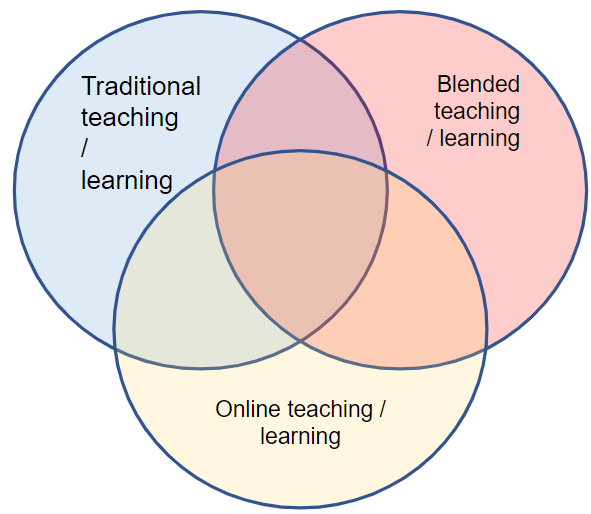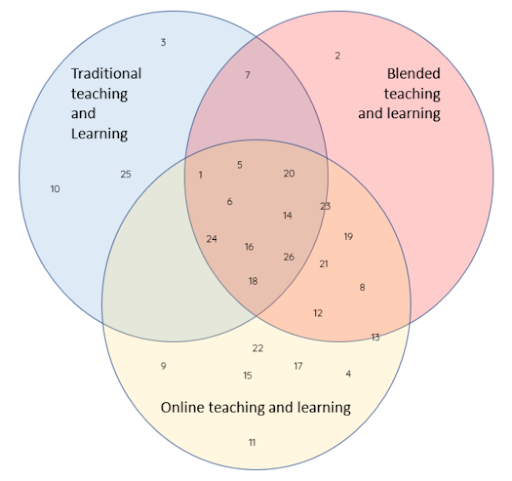
Teaching and learning: from traditional to blended and online courses
Teaching and learning: from traditional to blended and online courses
This module examines the pros and cons of the proliferation of technology in (VET) education, helping tutors to see digital literacies, e-learning platforms, and digital tools as “friends”.
This module offers you:

INTRODUCTION
Aim & Learning Outcomes
THEORETICAL BACKGROUND
Key concepts, background information, relevant theories
ACTIVITIES
Exercises, self-reflection & practical resources to promote inclusive e-learning
USEFUL TIPS
Advice, ideas and proposals on relevant issues
USEFUL READING
References and further reading
Aim
A module that examines the pros and cons of the proliferation of technology in (VET) education, helping tutors to see digital literacies, e-learning platforms and digital tools as “friends”
Learning objectives
After the completion of this module, learners (VET teachers/trainers/educators and also VET providers/Staff, as well as other key actors of educational sector) will be able to:
- summarise the current “online learning situation” in the (post) pandemic era
- start planning effective e-learning courses
- reflect on the educator’s changing role in today’s technology-driven world
At the end of this module you will know how to…
- Clarify the term “digital literacy” (or literacies, in plural)
- Discuss the transition from traditional to hybrid/blended & online teaching and learning, especially in the (post)COVID-era
- List the pros and cons of synchronous and asynchronous classes for both teachers and students
- Explain the basic factors that affect online course quality
- Develop/write learning objectives & learning outcomes especially for online courses
- Apply effective online course delivery practices (e.g. active use of emails, video messages, phone calls, messages through LMS, comments on shared documents, etc. to personalise teaching)
- Deliver basic online courses (basic platforms? MOOCS?)
- Self-reflect on how technology can change the instructors’ and students’ roles
- Weigh the use of gamification, Augmented and Virtual Reality (AR and VR), Artificial Intelligence (AI) and learning analytics in their own lessons
THEORETICAL BACKGROUND

This modules demonstrates the benefits of three different units:
- Clarify the term “digital literacy” (or literacies, in plural)
- Discuss the transition from traditional to hybrid/blended
& online teaching and learning, especially in the (post)COVID-era - List the pros and cons of synchronous and asynchronous
classes for both teachers and students
Unit 5.1: Clarify the term “digital literacy” (or literacies, in plural)
Fill the definitions with the following missing words:
numeracy, changing, reading, sectors, understanding, digital, europeans, digital
“Beyond its conventional concept as a set of ___________, writing and counting skills, literacy is now understood as a means of identification, ___________, interpretation, creation, and communication in an increasingly __________, text-mediated, information-rich and fast-___________ world.”
UNESCO
“In Europe, more than 90% of professional roles require a basic level of ________ knowledge, just as they require basic literacy and __________ skills. The use of digital is spreading across all __________ from business to transport and even to farming. Yet, around 42% of ____________ lack basic digital skills, including 37% of those in the workforce.”
European commission
Unit 5.1: Clarify the term “digital literacy” (or literacies, in plural)
“Beyond its conventional concept as a set of reading, writing and counting skills, literacy is now understood as a means of identification, understanding, interpretation, creation, and communication in an increasingly digital, text-mediated, information-rich and fast-changing world.”
“In Europe, more than 90% of professional roles require a basic level of digital knowledge, just as they require basic literacy and numeracy skills. The use of digital is spreading across all sectors from business to transport and even to farming. Yet, around 42% of Europeans lack basic digital skills, including 37% of those in the workforce.”
https://digital-strategy.ec.europa.eu/en/policies/digital-skills
Unit 5.1: Clarify the term “digital literacy” (or literacies, in plural)
- Using OECD’s « Education GPS* », find data about Adult skills in your country and compare it with other EU countries.
- Find, using this tool the rate of adults (16-65 years old) who report no prior experience with computers or lack very basic computer skills.

Unit 5.2:Discuss the transition from traditional to hybrid/blended & online teaching and learning, especially in the (post)COVID-era
In 2020, we all had to swiftly move to online teaching / learning due to COVID. It was, to say the least, unsettling.
What are, in your opinion, the long-term changes initiated by the COVID outbreak to the field of learning and teaching?
Unit 5.2:Discuss the transition from traditional to hybrid/blended & online teaching and learning, especially in the (post)COVID-era
- Create a Venn diagram
- Organise the elements (listed on the next page) on the diagram.
You may want to add your own fabulous ideas!
Place the following elements on your Venn diagram (use numbers only):
- Instructors can read the participants’ reactions
- Requires physical space occasionally
- Requires physical space very regularly
- Does not require physical space to meet
- Participants can collaborate
- Course aims and objectives must be clearly defined
- Instructors can observe participants in person
- Requires higher level of independence and discipline from participants
- No time spent on commute
- Mostly synchronous
- Mostly asynchronous
- Requires Internet access
- Learning can take place 24/7
- Attendance can be measured
- Promotes equality: no matter how far from the physical institution you live
- Can use technology
- Participants may not meet physically at all
- Peer to peer interaction is possible
- Higher risk of inequality: lack of material or comfortable place to work
- Is learner-centred
- Increases screen time
- Is completely self-paced, participants can work according to their personal rhythm (deadlines must be met though)
- Communication takes place electronically
- Needs to be well-structured
- Place and type of furniture in the room is of critical importance
- Requires a qualified instructor
Unit 5.2:Discuss the transition from traditional to hybrid/blended & online teaching and learning, especially in the (post)COVID-era
Compare your result with the suggested answer and/or look for similar diagrams online
As a result, we can list 5 good practice in online or blended learning and teaching.
Good online or blended learning and teaching:
- Improves the contact between learners and instructors
- Encourages cooperation among learners
- Emphasizes active learning
- Provides prompt feedback
- Considers diverse learning talents and capacities
Unit 5.3: List the pros and cons of synchronous and asynchronous classes for both teachers and students
According to the Erasmus+ website, synchronous and asynchronous learning are defined as follows: “Synchronous: all types of learning where teachers/educators and learners are in the same place [whether online or in person] and at the same time. Asynchronous learning: all types of learning that do not occur in the same place and at the same time.”
Key point: Synchronous learning makes it possible for immediate feedback to happen. Asynchronous learning allows the course participants to work at their own pace.
Unit 5.3: List the pros and cons of synchronous and asynchronous classes for both teachers and students
Would you say the following activities are synchronous or asynchronous?
Fill the chart with your own ideas and experience considering pros and cons of synchronous or asynchronous learning and teaching:
Suggested answer

ACTIVITIES
ACTIVITY 1
“There is always room for improvement”
Through this activity, you will discover factors that affect online courses quality through the realisation of a synthesising visual
Familiarise yourself with the corpus of documents (recommended time 10 minutes)
- Document 1: Infographic
- Document 2: Article
- Document 3: Video
Using the tool of your choice (eg. Canva), create a visual (eg. Mind map, poster) to synthesise all relevant information gathered.
Improve your visual in the light of your findings from units 5.1, 5.2 and 5.3:
- digital literacy,
- traditional, blended and online learning & teaching,
- synchronous and asynchronous tasks)
- In what ways are we different but still same?
Review your visual, bearing in mind we’re trying to achieve quality within e-learning environments which promote diversity, tolerance and therefore inclusiveness.
Doc1: Gilly Salmon’s five stages of development through the online experience:
The system is set up and accessed and participants are welcomed and encouraged
Messages are sent and received and participants get used to being in the online environment
Information exchanges flow freely and participants are encouraged to become independent, confident and enthusiastic about working online
Participants begin to interact with each other in more exposed and participative ways
Participants become responsible for their own learning

Doc2: Read the article Source: the OpenUpEd label self-assessment (EN)
Doc3: Browse through the video (you do not need to watch the whole video) Quality Online Teaching by NIU Center for Innovative Teaching and Learning
Checklist – Instructions “Have I followed instructions?”

Checklist – Content “Have I included the necessary elements?”
ACTIVITY 2
“Know before you go”
Through this activity, you will self-assess the quality of your digital learning objectives and digital learning outcomes using an online tool
« Common ground »
- Differentiate learning objectives and learning outcomes
- Agree on common features of all learning objectives
Contextualise your activity as a VET professional and phrase objectives for your next online sessions
Check that your learning objective contains all required part by running it into an online tool
Below you’ll see a series of 4 statements. Decide whether you agree or disagree with each of them
1. « Learning objectives and learning outcomes are the same thing. »
Click to reveal the correct answer
To make sure you understand the difference between those two, you can check the following links:
2. « Objectives and outcomes must be written so that they’re not ambiguous. »
Click to reveal the correct answer
It is essential that both learning objectives and learning outcomes are unambiguous.
3. « Learning outcomes must include (amongst other things) the description of a learner’s performance through a verb of action»
Click to reveal the correct answer
We can base our choice on Bloom’s 6 level taxonomy to choose the right verb.
In a digital learning context, specific taxonomies have been developped, such as this one developped by TeachThought Staff.
4. « Learning outcomes must include two essential components: the learner’s performance as described earlier and another one. »
Click to reveal the correct answer
According to Mager (1997), there are three essential components to building learning objectives and outcomes:
- A performance
- Conditions under which the learner must perform (eg. without help, as a group, relying on their notes, in 1h…)
- Criteria for assessor to decide whether the learner is successfull (eg. without mistakes, with a minimum of 75% of correct answers...)
- Describe the audience you’re currently working with.
- List the topics / subjects you’re currently working on with learners.
- List learning objectives you’re planning on achieving in the near future.
- Phrase learning objectives and outcomes for your next online sessions.
“Know before you go”
Make sure your objectives are well designed and phrased by running them into this online generator, developed by a wide team of professional including tech experts, teachers and designers.
You can post your results on this Padlet, using the relevant column.
This will allow you to compare and comment your work with others. You can receive feedback from other participants as well.
ACTIVITY 3
“Get better”
Through this activity, you will question your role as a VET professional
Agree on a definition of course delivery practices
When talking about delivery practices, we mean:
- Planning and moderating communication:
- Which communication channels are you going to use to communicate with all learners at once?
- How will you communicate with learners individually?
- How should learners contact you?
- Which tools are available for learners to communicate with one another?
- Will you offer a communication channel to facilitate social interactions?
- Making learning material available to the learners
- How are you going to share materials with the learners?
- When will learning material be shared with the learners?
- How will learners submit their work (if relevant)?
- How will you provide feedback?
Compare your ideas with the suggested answers
Suggested answer:
Which communication channels are you going to use to communicate with all learners at once? – Group e-mails (list)
Sure, it’s a way!
Advantages:
- No need to be a tech expert to use
- Learners should encounter no difficulties accessing information
Limits:
- Learners might not want their email addresses to be shared with the whole group
🡪 Keep in mind you can use the « Bcc » entry to protect the participants’ privacy.
- Too many emails per day / per week, especially if poorly structured, can start causing annoyance to your audience
Suggested answer:
How should learners contact you? – Make an appointment through an online shared calendar
It’s a good start! Learning Managment Systems like Moodle if you use one would offer such an option. Online tools such as Zoho Bookings offer similar options for free.
Advantages:
- Automatized system: avoids conflicts (eg. agreeing on multiple appointments at the same time by mistake)
- Avoids sending multiple messages to agree on a meeting
Limits:
- Learner might need to be guided to use the tool for the first time
- Only delayed contact is possible 🡪 learners may want to get in touch with you quickly for specific questions
Suggested answer:
Which tools are available for learners to communicate with one another? – Personal phone call or SMS
Be careful here! Sharing your learners’ personal contact with a third party requires for you to ask whether they’d be comfortable with that. It is essential that you respect their privacy.
Suggested answer:
Will you offer a communication channel to facilitate social interactions? – No
Hmmm… Have you thought that well? It’s a pity not to encourage your learners to interact with each other by planning a way to communicate on a less formal level.
As seen in Activity one: « There is always room for improvement », learners benefit from social interaction when following online courses. That can truly enhance their experience and boost their engagement.
Suggested answer:
When will learning material be shared with the learners? – All material will be available on course day 1
Why not but…
Advantages:
- The course is truly self-paced: learners navigate the course at their own rhythm.
Limits:
- Requires a very high level of organisation and independence from the learners.
- Learner might get lost, jump too fast to tasks or get stuck, spending too much time in one place
🡪 A well designed, clearly structured course will help learners navigate and find their way.
Design your own online activity and plan the delivery practice.
Using the learning objectives and learning outcomes you developped in the second activity « Know before you go », create an activity based on a video using the TedEd platform*.
Example:
- Select a video related to your lesson topic on TedEd. As an alternative, you can select any video on YouTube and paste the link into the TedEd search engine
- Follow the instructions on the platform to create your own questions*
- Check the example available here* (EN) or here (FR) to help
- How would you plan the delivery practices around this activity? Describe your context briefly and use the previous example to build your own set of delivery practices.
Suggested answer
I work with a group of 10 people. An online classroom is set up for the 21/11/2024 where we’ll go through the material learners have worked on autonomously. The TedEd activity is part of the self-directed activities done before the meeting (between the 18th and the 20th).

Comment an instructor’s set of choices when it comes to online course delivery practices
Here is an example. Comment the relevance of each of the instructor’s choices following the prompt next slide

Prompt:
General comment
Advantages:
- List advantages (1)
- List advantages (2)
- …
Limits:
- List limits (1)
🡪 Offer an alternative or a solution
- List limits (2)
USEFUL TIPS
Useful Tips!
Explore platforms where to deliver basic online courses
Moodle has been mentioned many times, it is the platform we’ve chosen to deliver this course.
It’s called an LMS (Learning Management System). It offers a great diversity of options and interactivity.
While doing activity 3, you’ve explored options offered by the TedEd platform.
To explore other option, you can have a look at:
- Mooc platforms – the link sends you to a table listing Mooc platforms and their main characteristics
- Kahoot and Mentimeter – allow you to create interactive quizzes
- Wordwall – allows you to create fun, interactive activities
- Zoom, Microsoft Teams, Google Meet – allow you to meet in an online classroom
Which of these have you previously used? Which would you plan on using in the near future?
Hear a professional’s opinion about tech’s impact on instructors’ roles at a conference
Browse through the following video which develops Anna Hasper’s opinion on our role as instructors. You do not need to watch the whole video. Take notes while watching, especially about:
- teacher’s competencies
- how to create a supportive learning community.
Video’s author:
International House Torun – ONLINE Teacher Training Day
Audio in English
Subtitles available in a variety of languages (automatically translated)*
Duration: 45’20
Useful Tips!
From your notes, can you highlight the following:

Do you agree with these elements? Why / Why not?
Is there anything else you would like to add about this video?
Suggested answers: From your notes, can you highlight 2 key elements from Anna Hasper’s talk ?

Weight the use of cutting-edge technologies in your own lessons Watch a video which illustrates a variety of cutting-edge technologies in education. Then, answer the question: https://youtu.be/Fc1hjxiEfas
Which cutting-edge technologies for education are mentioned in the video?
- Gamification
- Learning through augmented reality (AR)
- Mail merging
- Learning through virtual reality (VR)
- Artificial intelligence (AI)
- Using chat-bots in digital learning contexts
- Learning analytics
Which of these technologies are you aware of? Which have you used? Which would you like to have a chance to discover?
Share your thoughts in the video comments!
KEY TAKEAWAY
“Transforming content to online learning”

You as teacher/trainer are the best person to transform the content you teach in class or training as an online content.
Feel free to use all technical tools you are confortable with and question yourself: « Would I take this class and use those materials ? ». Then you are on the right path to create interesting contents. For your students.
Online content should be as intersting than offline contents !
Well done! Now it’s “quiz time”! Then you can try the next module!
The European Commission’s support for the production of this publication does not constitute an endorsement of the contents, which reflect the views only of the authors, and the Commission cannot be held responsible for any use which may be made of the information contained therein
project number : 2021-1-FR01-KA220-VET-








